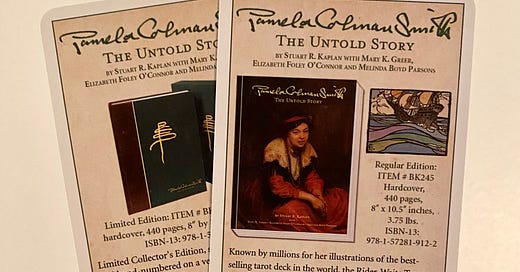I almost forgot to write tonight’s newsletter, which is funny because I’d had the topic in mind since last Sunday, when I unwrapped a new deck of tarot cards. I’d never really paid attention to two cards at the top of the deck, but this time a signature caught me eye: That of Pamela Colman Smith, the illustrator of the Rider-Waite-Smith deck.
Though tarot is a divination practice dating back to at least the mid-15th century, the Rider-Waite-Smith deck, published in 1909, is thought of as the “traditional” and most popular modern tarot deck. Prior decks were heavily influenced by Christian imagery, but, by renaming a few characters and changing some symbols, Arthur Edward Waite created a more widely accessible deck at a time where mysticism was gaining popularity in the middle class.
Waite was the author, William Rider was the publisher, and Pamela Colman Smith was the illustrator of the collaborative cards. The deck is often referred to as Rider-Waite, which is blatant erasure of Smith, the Black woman who brought the cards to life with her vivid, allegoric illustrations. So, in this house, we say Rider-Waite-Smith.
Smith, nicknamed “Pixie,” was born in London in 1878 to an English father from a prominent political family and a Jamaican mother. She spent time in England and Jamaica before moving to Brooklyn at the age of 15, where she enrolled in art school. She was heavily influenced by her time in Jamaica, taking with her the folklore and mysticism of her mother’s homeland. She’d go on to write and illustrate books of Jamaican stories as an adult.
Her illustration style matured at the Pratt Institute, where she was influenced by the end of the Arts and Crafts movement, a style defined by romanticism, symbolism, and fin de siècle, a French phrase meaning “end of cycle,” referring to the stylistic mood of the end of the 19th century.
Though she never found much commercial success, she worked as an artist throughout her life, designing posters for the British suffrage movement and for World War I efforts. In 1901, she joined the Hermetic Order of the Golden Dawn, a secret society dedicated to metaphysics and the occult. It was here she met Waite, who commissioned her to illustrate his modernized tarot deck. They worked as a design team, with Waite giving Smith his perspective on the meaning of each card, but it was she who conceived of the phantasmagoric cards of the Major Arcana. She also took visual cues from the 17th century Tarot of Marseilles and the 15th century Sola Busca tarot. Smith illustrated in ink and pencil and added color with watercolors, so the hyper-saturated cards we see today are an effect of digitalization and modern printing.
Perhaps subconsciously influenced by the Catholic imagery of these Italian decks, Smith converted to Catholicism in 1911. After receiving a family inheritance, she opened a vacation home for Catholic priests in the artists’ community of Lizard Peninsula in Cornwall, England. Isn’t that funny? One of the most influential figures in modern mysticism spent some of her final years running a British priest resort. I love it.
I hope you do, too.
Until next week,
Elizabeth
This newsletter is just one facet of Zhuzh, my platform dedicated to conscious consumption and making space for delight. I offer secondhand-and-vintage-based wardrobe and interior styling services, art curation, and super chill life coaching. Keep up with me on Instagram and learn more at www.zhuzhlife.com.




